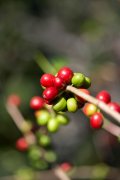Chinese people drink coffee China Coffee Network Coffee introduced into China Coffee Trading Network
Coffee introduced into China
From the perspective of language, the Kangxi Dictionary has neither the word "coffee" nor the word "coffee", let alone the word "coffee". It can be seen that the Chinese people in the early Qing Dynasty did not come into contact with coffee. Whether there is any coffee (beverage) in China in the middle of the Qing Dynasty is still under search. The author carefully examined several kinds of dictionaries, dictionaries and other books from the middle of Qing Dynasty to the end of Qing Dynasty published by Shanghai Ancient Books Publishing House in 1989, and got nothing. For example, the popular articles compiled by Zhai Hao in the Qianlong year of the Qing Dynasty (published by the Commercial Press in 1958), the Shi Feng Records of Gu Zhangsi in the Jiaqing year of the Qing Dynasty, the prose of Hao Yixing in the Jiaqing year of the Qing Dynasty, and the Zhengyin Summary of the Gao Jingting Pavilion in the Light year of the Qing Dynasty, and so on. At first, the Chinese translation of Coffee must be different, such as "eating fat" and so on. ① also does not rule out the possibility of being transliterated into other words. However, the official name "Coffee" in Chinese today should be derived from the Japanese word for "Jia Jia". Because as mentioned earlier, the Japanese first contact and write down the coffee, first open a coffee shop, and write it as "Jia Jia". Japan has invaded China on a large scale since 1894. Therefore, it is named "Coffee" in Chinese. As far as I know, the earliest word "coffee" probably appeared in the China Great Dictionary (Zhonghua Book Company, 1915) in the early years of the Republic of China, which also means "coffee, Western drinks, such as tea in China, English Coffee". Since then, the word "coffee" has been included in Ciyuan, which was published in the 1930s, and it has been explained in detail and correctly. It can be seen that the word "coffee" entered the Chinese vocabulary and was widely used in the era of the Republic of China.
It seems difficult to determine when and where foreigners come to China to brew and drink their own coffee in China. However, it is now known that during the Jiaqing period before the Opium War, foreigners who came to Guangzhou, China's largest trading port at that time, had already made and drank their own coffee. Chinese people also feel this kind of eating habit. "there is wine in foreign countries. There is also black wine, and ghosts drink it after dinner, and this wine can be consumed. ② according to "Guangdong Tongzhi" said that the ghost, black wine, drink after meals, can help digestion and other judgment, the so-called black wine, should refer to coffee. Some similar cocoa is made into chocolate, and it is as popular as coffee-free drinks.
Individual Chinese began to taste and drink coffee probably during the Tongzhi period. In the fifth year of Tongzhi (1866), Mrs. Gopiti, an American missionary in Shanghai, published a book on making Foreign Rice, which was written for foreigners who came to China to eat western food and train Chinese cooks and cooks. In addition to translating coffee into "fattening", the book also teaches the methods of making and cooking coffee: "roasting and fattening in a fierce fire, shoveling frequently, so as not to scorch it black." Bake well, add a little cream while it is hot, cover it in a covered bottle, and roll it when you want to use it. ③ first talked about roasting and roasting coffee beans. When you want to boil a drink, crush it and cook it immediately. Later, we will talk about how to add water to make coffee and so on. But it doesn't talk about adding sugar. There may be some omissions. Those who are trained by foreigners to cook western food and brew coffee are mostly employed Chinese, and they inevitably do not have a sip of coffee because of their work needs. When foreigners eat western food and drink coffee in China, they sometimes invite Chinese officials and their Chinese acquaintances to eat and drink. It can be seen that some Chinese people have tasted coffee during the Tongzhi period. The emergence of operational cafes in China was probably at the end of the Qing Dynasty. According to Xu Ke, a man at the end of the Qing Dynasty and the beginning of the Republic of China, "drinking coffee: there are coffee shops in Europe and the United States, just like teahouses in China." It is also available in Tianjin and Shanghai, and it is also imitated by the Chinese. Concurrently sell candy to drink. Xu Ke's book takes a lot of notes from the Qing Dynasty, and it can be inferred that the things mentioned appeared at the end of the Qing Dynasty. However, this book was published a little later than the China University Dictionary, so it is difficult to tell which book uses the word "coffee" first. However, the first to be printed in type is the Chinese Dictionary. It can be seen that coffee shops attached to cafes or hotels and guesthouses generally appeared in major cities in the Republic of China.
_ _
① see Gao Pi Di in the five years of Tongzhi of the Qing Dynasty: making Foreign Food Books 251st, China Commercial Publishing House. 1986, p. 52.
② Qing Jiaqing Chen Changzhai et al., Guangdong Tongzhi Vol. 95, "Grain products of Public opinion", cited "Boat car smell record", Tongzhi three years edition, p. 1646.
Gao Pidi, ③ Tongzhi: making Foreign Food Books, 251, p. 52.
It is even more unclear when and where coffee was introduced in China and how it spread. The Chinese Encyclopedia Agricultural Volume Coffee Bar and the Chinese Agricultural Encyclopedia Agricultural Volume Coffee Bar all said that coffee was introduced to Taiwan Province of China in 1884, introduced to Hainan Province in 1908, and then introduced to Yunnan, Guangxi, Fujian and other places. However, there is no documentary evidence, no data source, and no argument or reference in the article. Therefore, it remains to be verified. According to the clues provided by the author, I consulted the continuation of the Annals of Taiwan written by Yu Wenyi in the late Qianlong year of the Qing Dynasty, the General Chronicles of Taiwan compiled collectively in the reign of Emperor Guangxu, and the Tongzhi of Fujian compiled by Chen Shouqi and others in the late Qianlong year of the Qing Dynasty. Chen Changzhai wrote Guangdong Tongzhi, Xie Qikun supervised Guangxi Tongzhi in Qing Jiaqing year, and continued Yunnan Tongzhi manuscript by Wang Wenshao in Qing Guangxu year. I have carefully studied the "products" and "local suitability" parts of various prefectures and counties, but have not yet found any clues to plant and produce coffee. In addition, the author also consulted the New compilation of Bowu by the British in the year of Qingxian and Fengnian, and the textual Research on the name and reality of plants by Wu Qirong and its long compilation, which were not mentioned in the book. Therefore, this work has to go on, and we look forward to the benefit of those who know. The first introduction of coffee by Chinese mainland probably began in Yunnan in the 1920s. At that time, a French missionary brought a batch of coffee seedlings to Binchuan County, Dali Prefecture, Yunnan Province for cultivation. ① Yunnan has a subtropical climate, which belongs to the sphere of influence of France in modern times, and Vietnam and Laos bordering it are already French colonies. Therefore, I think it is more credible that the French introduced coffee cultivation into Yunnan at the beginning of the 20th century. By the time of the Republic of China, it had been confirmed that coffee had been cultivated and produced in the field. In Taiwan Province from 1926 to 1936, the Japanese colonial authorities encouraged the cultivation of crops designed to squeeze sugarcane and rice, including coffee. [7] (p368) from 1932 to 1942, coffee was also among the larger crops in Taiwan's sown area. [7] (p370) introduction and cultivation are also available in Hainan, Guangdong, Guangxi, Yunnan and other places on the mainland of the motherland. So now we can only be sure that there was coffee cultivation and production in China on the eve of the Republic of China and in the Republic of China era. Coffee cultivation has developed after liberation. [1] (P258-259)
Important Notice :
前街咖啡 FrontStreet Coffee has moved to new addredd:
FrontStreet Coffee Address: 315,Donghua East Road,GuangZhou
Tel:020 38364473
- Prev

Coffee Entering China Time Imported Coffee Local Coffee Coffee History Origin
As Starbucks 'banshee image gradually became familiar to Chinese people, Chinese coffee culture slowly entered the lives of Chinese people. Throughout the history of coffee culture in China, perhaps we can find the footsteps of coffee, the birthplace of the ancient Arab culture invading the world tea culture. History records that as early as 2,000 BC, Ethiopia's Ajiao people had already been in
- Next

American Fine Coffee Association Specialty Coffee Association ofAmerica boutique
SCAA, the full name Specialty Coffee Association ofAmerica, translated into Chinese as the American Special Coffee Association, and a small number of people call it the American Fine Coffee Association. SCAA is the largest coffee trade association in the world and a trade organization focusing on high-quality coffee. Founded in 1982, SCAA has more than 3, 000 member companies in more than 40 countries around the world.
Related
- What ratio of water temperature and ground does the smart cup method use to press coffee? The difference between brewed coffee and filtered coffee?
- What is the standard process for the purpose of coffee cup testing? What is the difference between hand-brewed coffee and cup testing?
- How to use hand-brewed coffee paragon small golden balls? How does cold coffee lock in the aroma of coffee?
- Is American coffee black? What is the difference between American coffee and drip coffee?
- Unexpected! Well-known tea beverage brand Lele Tea will withdraw from the Zhengzhou market!
- Starbucks enters the fashion and beauty industry?! Netizen: Give me an ice American eye cream
- Why can American refills for free? The difference between Americano and American drip pot coffee
- Being chased out of the rain in front of Starbucks?! Store: Sheltering from rain under umbrellas poses a safety hazard
- The white moonlight has changed?! Lucky launches "Big Winter Pear American"
- Hand-brewed coffee three-stage method, high-sweet and universal brewing method to share! What does the high sweet water level of hand-brewed coffee mean?

